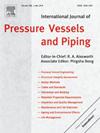Piping structural health monitoring: ANN methods for internal semi-elliptical crack detection
IF 3
2区 工程技术
Q2 ENGINEERING, MECHANICAL
International Journal of Pressure Vessels and Piping
Pub Date : 2024-12-25
DOI:10.1016/j.ijpvp.2024.105417
引用次数: 0
Abstract
This study investigates the detection and characterization of longitudinal internal semi-elliptical cracks in circular steel pipes using artificial neural networks (ANNs) within a structural health monitoring framework (SHM). Internal semi-elliptical cracks, which are prevalent in pipes and pressure vessels and challenging to detect with conventional non-destructive testing methods, are modeled to evaluate their impact on natural frequencies and mode shapes. Finite element simulations are validated against analytical and numerical data to ensure accuracy. The results reveal that an increase in the crack's large diameter, while maintaining a constant depth, significantly reduces the natural frequencies. ANN models employing cascade forward back propagation (CFBP) and feed forward back propagation (FFBP) algorithms are developed to predict the shape and location of cracks based on natural frequency data. The models are trained and tested using 78 datasets derived from vibration responses of six geometric crack ratios at varying positions, employing the k-fold cross-validation method with k = 6. The CFBP algorithm demonstrates superior performance, achieving a high correlation coefficient of 0.98898 in crack detection. The novelty of this work lies in addressing the complex effects of semi-elliptical cracks on structural responses and leveraging natural frequency shifts as diagnostic parameters. This approach bridges a critical research gap by providing a robust methodology for detecting concealed internal cracks in pressure vessels, advancing SHM practices.
求助全文
约1分钟内获得全文
求助全文
来源期刊
CiteScore
5.30
自引率
13.30%
发文量
208
审稿时长
17 months
期刊介绍:
Pressure vessel engineering technology is of importance in many branches of industry. This journal publishes the latest research results and related information on all its associated aspects, with particular emphasis on the structural integrity assessment, maintenance and life extension of pressurised process engineering plants.
The anticipated coverage of the International Journal of Pressure Vessels and Piping ranges from simple mass-produced pressure vessels to large custom-built vessels and tanks. Pressure vessels technology is a developing field, and contributions on the following topics will therefore be welcome:
• Pressure vessel engineering
• Structural integrity assessment
• Design methods
• Codes and standards
• Fabrication and welding
• Materials properties requirements
• Inspection and quality management
• Maintenance and life extension
• Ageing and environmental effects
• Life management
Of particular importance are papers covering aspects of significant practical application which could lead to major improvements in economy, reliability and useful life. While most accepted papers represent the results of original applied research, critical reviews of topical interest by world-leading experts will also appear from time to time.
International Journal of Pressure Vessels and Piping is indispensable reading for engineering professionals involved in the energy, petrochemicals, process plant, transport, aerospace and related industries; for manufacturers of pressure vessels and ancillary equipment; and for academics pursuing research in these areas.

 求助内容:
求助内容: 应助结果提醒方式:
应助结果提醒方式:


